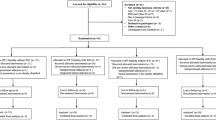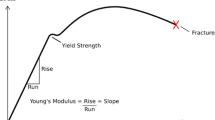Abstract
Background
Despite widespread use of the endoscopic technique in the treatment of inguinal and incisional hernias, knowledge about its impact on abdominal wall wound healing is rare. Questions remain regarding the risk of port-site hernias and hernia recurrence. The current study investigated the gas-dependent effects of pneumoperitoneum on laparotomy wound healing.
Methods
Laparotomy was performed in 54 male Sprague–Dawley rats. A carbon dioxide (n = 18) or helium (n = 18) pneumoperitoneum of 3 mmHg was maintained before and after laparotomy, with an overall duration of 30 min. The rats in the control group (n = 18) received no pneumoperitoneum. The animals were killed after 5 and 10 days, and the abdominal wall was explanted for subsequent histopathologic examinations of the laparotomy wound. The granuloma formation in hematoxylin and eosin–stained sections was analyzed. Infiltration of macrophages (CD68) and expression of matrix metalloproteinases (MMP-8 and MMP-13) were examined by immunohistochemistry. The collagen type 1 to type 3 ratio was investigated by cross-polarization microscopy after Sirius Red staining.
Results
After 5 and 10 days, the percentages of CD68-positive cells, granuloma formation, and expression of MMP-8 did not differ between the groups. In contrast, after both 5 and 10 days, the expression of MMP-13 and the collagen 1 to 3 ratio were significantly higher after helium pneumoperitoneum than in the control animals.
Conclusions
The results suggest that helium pneumoperitoneum may ameliorate wound healing within the abdominal wall and could therefore represent a beneficial gas for endoscopic hernia repair.





Similar content being viewed by others
References
LeBlanc KA (2005) Incisional hernia repair: laparoscopic techniques. World J Surg 29: 1073–1079
Bay-Nielsen M, Kehlet H, Strand L, Malmstrom J, Andersen FH, Wara P, Juul P, Callesen T (2001) Quality assessment of 26,304 herniorrhaphies in Denmark: a prospective nationwide study. Lancet 358: 1124–1128
Cohen RV, Alvarez G, Roll S, Garcia ME, Kawahara N, Schiavon CA, Schaffa TD, Pereira PR, Margarido NF, Rodrigues AJ (1998) Transabdominal or totally extraperitoneal laparoscopic hernia repair? Surg Laparosc Endosc 8: 264–268
Si Z, Rhanjit B, Rosch R, Rene PM, Klosterhalfen B, Klinge U (2002) Impaired balance of type I and type III procollagen mRNA in cultured fibroblasts of patients with incisional hernia. Surgery 131: 324–331
Zheng H, Si Z, Kasperk R, Bhardwaj RS, Schumpelick V, Klinge U, Klosterhalfen B (2002) Recurrent inguinal hernia: disease of the collagen matrix? World J Surg 26: 401–408
Junge K, Klinge U, Rosch R, Mertens PR, Kirch J, Klosterhalfen B, Lynen P, Schumpelick V (2004) Decreased collagen type I/III ratio in patients with recurring hernia after implantation of alloplastic prostheses. Langenbecks Arch Surg 389: 17–22
Klinge U, Si ZY, Zheng H, Schumpelick V, Bhardwaj RS, Klosterhalfen B (2001) Collagen I/III and matrix metalloproteinases (MMP) 1 and 13 in the fascia of patients with incisional hernias. J Invest Surg 14: 47–54
Klinge U, Si ZY, Zheng H, Schumpelick V, Bhardwaj RS, Klosterhalfen B (2000) Abnormal collagen I to III distribution in the skin of patients with incisional hernia. Eur Surg Res 32: 43–48
Agalar F, Hamaloglu E, Daphan C, Tarim A, Onur R, Renda N, Sayek I (2000) Effects of CO2 insufflation and laparotomy on wound healing in mice. Aust N Z J Surg 70: 739–742
Murray JA, Cornwell EE, III, Velmahos GC, Rivkind AI, Hedman T, Abrahams JH, Katkhouda N, Berne TV, Demetriades D (2001) Healing of traumatic diaphragm injuries: comparison of laparoscopic versus open techniques in an animal model. J Surg Res 100: 189–191
Wickens JC, Whelan RL, Allendorf JD, Donahue J, Buxton E, McKee A, Panageas K, Gleason N, Lee S, Bessler M (1998) Wound tensile strength and contraction rate are not affected by laparotomy or pneumoperitoneum. Surg Endosc 12: 1166–1170
Robbins SB, Pofahl WE, Gonzalez RP (2001) Laparoscopic ventral hernia repair reduces wound complications. Am Surg 67: 896–900
Ikechebelu JI, Obi RA, Udigwe GO, Joe-Ikechebelu NN (2005) Comparison of carbon dioxide and room air pneumoperitoneum for day-case diagnostic laparoscopy. J Obstet Gynaecol 25: 172–173
Kollmorgen CF, Thompson GB, Grant CS, van Heerden JA, Byrne J, Davies ET, Donohue JH, Ilstrup DM, Young WF (1998) Laparoscopic versus open posterior adrenalectomy: comparison of acute-phase response and wound healing in the cushingoid porcine model. World J Surg 22: 613–619
Gutt CN, Kuntz C, Schmandra T, Wunsch A, Heinz P, Bouvy N, Bessler M, Sanger P, Bonjer J, Allendorf J, Jacobi CA, Whelan R (1998) Metabolism and immunology in laparoscopy: first workshop on experimental laparoscopic surgery, Frankfurt, 1997. Surg Endosc 12: 1096–1098
Collet D, Vitale GC, Reynolds M, Klar E, Cheadle WG (1995) Peritoneal host defenses are less impaired by laparoscopy than by open operation. Surg Endosc 9: 1059–1064
Chekan EG, Nataraj C, Clary EM, Hayward TZ, Brody FJ, Stamat JC, Fina MC, Eubanks WS, Westcott CJ (1999) Intraperitoneal immunity and pneumoperitoneum. Surg Endosc 13: 1135–1138
Jacobi CA, Ordemann J, Halle E, Volk HD, Muller JM (1999) Impact of laparoscopy with carbon dioxide versus helium on local and systemic inflammation in an animal model of peritonitis. J Laparoendosc Adv Surg Tech A 9: 305–312
Wildbrett P, Oh A, Naundorf D, Volk T, Jacobi CA (2003) Impact of laparoscopic gases on peritoneal microenvironment and essential parameters of cell function. Surg Endosc 17: 78–82
Rosch R, Stumpf M, Junge K, Ardic D, Ulmer F, Schumpelick V (2004) Impact of pressure and gas type on anastomotic wound healing in rats. Langenbecks Arch Surg 389: 261–266
Portera CA, Love EJ, Memore L, Zhang L, Muller A, Browder W, Williams DL (1997) Effect of macrophage stimulation on collagen biosynthesis in the healing wound. Am Surg 63: 125–131
Browder W, Williams D, Lucore P, Pretus H, Jones E, McNamee R (1988) Effect of enhanced macrophage function on early wound healing. Surgery 104: 224–230
Eljaafari A, Duperrier K, Mazet S, Bardin C, Bernaud J, Durand B, Gebuhrer L, Betuel H, Rigal D (1998) Generation of stable monocyte-derived dendritic cells in the presence of high concentrations of homologous or autologous serum: influence of extracellular pH. Hum Immunol 59: 625–634
Kuntz C, Wunsch A, Bodeker C, Bay F, Rosch R, Windeler J, Herfarth C (2000) Effect of pressure and gas type on intraabdominal, subcutaneous, and blood pH in laparoscopy. Surg Endosc 14: 367–371
Jackson PG Evans SR (2000) Intraperitoneal macrophages and tumor immunity: a review. J Surg Oncol 75: 146–154
Gutt CN, Heinz P, Kaps W, Paolucci V (1997) The phagocytosis activity during conventional and laparoscopic operations in the rat: a preliminary study. Surg Endosc 11: 899–901
Neuhaus SJ, Watson DI, Ellis T, Lafullarde T, Jamieson GG, Russell WJ (2001) Metabolic and immunologic consequences of laparoscopy with helium or carbon dioxide insufflation: a randomized clinical study. ANZ J Surg 71: 447–452
Wood GC, Keech MK (1960) The formation of fibrils from collagen solutions. 1. The effect of experimental conditions: kinetic and electron-microscope studies. Biochem J 75: 588–598
Vanamee P, Porter KR (1951) Observations with the electron microscope on the solvation and reconstitution of collagen. J Exp Med 94: 255–266
Nigra TP, Martin GR, Eagle H (1973) The effect of environmental pH on collagen synthesis by cultured cells. Biochem Biophys Res Commun 53: 272–281
Bard JB, Hulmes DJ, Purdom IF, Ross AS (1993) Chick corneal development in vitro: diverse effects of pH on collagen assembly. J Cell Sci 105: 1045–1055
Lopez-Rivera E, Lizarbe TR, Martinez-Moreno M, Lopez-Novoa JM, Rodriguez-Barbero A, Rodrigo J, Fernandez AP, Alvarez-Barrientos A, Lamas S, Zaragoza C (2005) Matrix metalloproteinase 13 mediates nitric oxide activation of endothelial cell migration. Proc Natl Acad Sci U S A 102: 3685–3690
Armstrong DG Jude EB (2002) The role of matrix metalloproteinases in wound healing. J Am Podiatr Med Assoc 92: 12–18
Nwomeh BC, Liang HX, Diegelmann RF, Cohen IK, Yager DR (1998) Dynamics of the matrix metalloproteinases MMP-1 and MMP-8 in acute open human dermal wounds. Wound Repair Regen 6: 127–134
Wu N, Jansen ED, Davidson JM (2003) Comparison of mouse matrix metalloproteinase 13 expression in free-electron laser and scalpel incisions during wound healing. J Invest Dermatol 121: 926–932
Paraskeva PA, Ridgway PF, Jones T, Smith A, Peck DH, Darzi AW (2005) Laparoscopic environmental changes during surgery enhance the invasive potential of tumours. Tumour Biol 26: 94–102
Vaalamo M, Mattila L, Johansson N, Kariniemi AL, Karjalainen-Lindsberg ML, Kahari VM, Saarialho-Kere U (1997) Distinct populations of stromal cells express collagenase-3 (MMP-13) and collagenase-1 (MMP-1) in chronic ulcers but not in normally healing wounds. J Invest Dermatol 109: 96–101
Acknowledgments
We thank the Karl Storz GmbH, Germany for the kind disposal of an insufflator modified for helium gas, and Mrs. Ellen Krott for careful assistance during this investigation.
Author information
Authors and Affiliations
Corresponding author
Rights and permissions
About this article
Cite this article
Rosch, R., Junge, K., Binnebösel, M. et al. Improved abdominal wall wound healing by helium pneumoperitoneum. Surg Endosc 20, 1892–1896 (2006). https://doi.org/10.1007/s00464-005-0816-z
Received:
Accepted:
Published:
Issue Date:
DOI: https://doi.org/10.1007/s00464-005-0816-z




